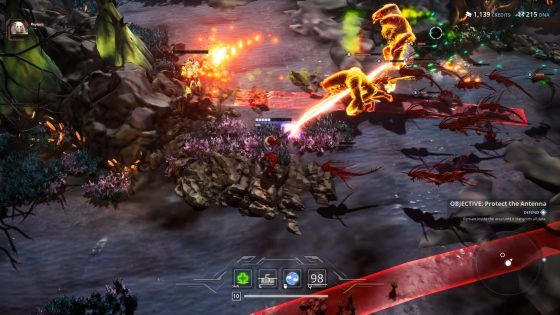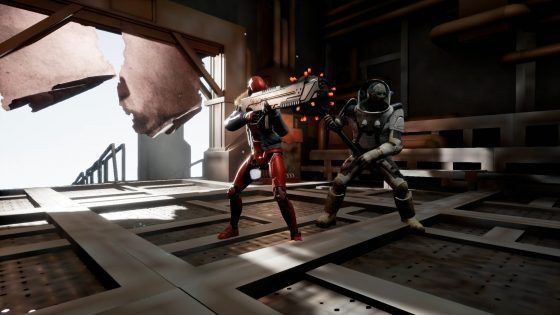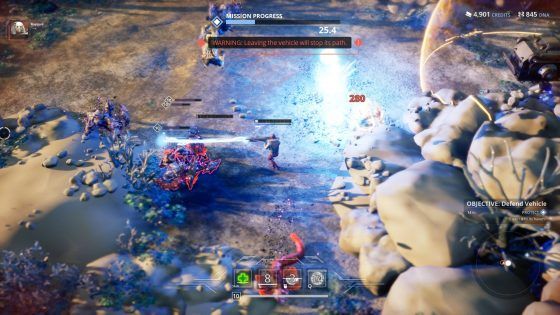Is it still a Diablo-like game if it stars space bounty hunters? Probably not, but Killsquad certainly qualifies as a loot-driven action RPG. The latest game from Spanish developer Novarama is a far cry from its most popular series, the family friendly Invizimals.
Killsquad is a sci-fi co-op action game where you can take on contracts solo or in a team of up to four players. Going in by yourself is far from the ideal way to enjoy Killsquad. In fact, it is detrimental to the experience and could give you the wrong impression about the potential of this game. Do yourself a favor and make some friends before playing. You’ll thank me later.
Bounty Hunters of the Galaxy
In my ill-informed mind, Killsquad was this story-driven co-op game where players would explore new planets and discover exciting new alien species, and blow them to pieces. That much I knew, or so I thought. Reality came knocking and it turns out, Killsquad doesn’t feature a proper campaign, and most likely never will. This is a game about loot and leveling up your hero, paving the way for more challenging and ultimately more rewarding contracts.
After subverting my expectations, for better and for worse, I was able to enjoy Killsquad for what it is; a fast-paced action RPG where loot matters and grinding is key. It may feel light on content during Early Access, but the core mechanics are in place and the wheels are in motion. While the theme couldn’t be more dissimilar, Killsquad feels remarkably close to Pagan Online, right down to the way that enemy waves appear out of thin air. Not my favorite mechanic, I must confess.
Killsquad features four space bounty hunters for you to choose from: Troy, Kosmo, Cass and Zero. While the selection is sparse, the heroes are diversified enough to suit most playstyles. My favorite of this bad bunch is Zero, a medical combat robot gone haywire. So much for empathy, as it is now a reckless murder machine, using its laser attacks to deal with any creatures. I’m also a fan of its ability to drop a MedPack, making it the perfect healer unit on the battlefield.
On the other hand, if you prefer to get up close and personal, Kosmo may be the right man… er, dead man for that. Wielding a massive sledgehammer, he isn’t afraid to use it to crack some alien skulls. Troy is the gunslinger and natural gambler, shooting his way to better loot. Finally, there’s Cass, the warrior nun, with her sharp sword and invisibility powers.
The grind may be strong with this one, but it’s not entirely unforgiving. You can stick to your favorite hero without second thoughts as you won’t be forced to start from scratch when you want to try the others. The support gear and prototype gear that you purchase from the shop is shared through all your characters, so you’ll swiftly find your brand-new space bounty hunter starting from Vector 31 or so. Weapons, however, are bound to each hero, so this is another aspect entirely.
Vector is the fancy name given to experience levels in Killsquad. This is a calculation based on your current equipment, which includes weapon, support gear and prototype gear. To make it perfectly clear, your overall ranking is the sum of the three gear parts divided by three, in case you find your Vector number not to be an exact reflection of your stats. It took me a while to discover its inner workings.
Contracts Make the World Go Round
With no campaign to sink your teeth into, you must pick one contract from the available selection. Contracts rotate in real time and are currently divided in three tiers: Recruit (Vector 1-30), Veteran (Vector 35-90) and Spec Ops (Vector 120-150). There is nothing preventing you from accepting contracts above your pay grade, but don’t get too cocky or you may end up seeing your mission cut short.
Killsquad’s Early Access features 12 contracts spread across three different planets. It’s a skimpy selection that is enhanced with day and night missions, but that doesn’t change the fact that this is a game in desperate need for additional content. Luckily, the maps are randomly generated, which means that you’ll face slightly different challenges. Sometimes you’ll struggle to find the right path, especially in The Palace of Pain, with a narrow pathway or two being harder to find than it should. Killsquad doesn’t feature character transparency, so it’s not uncommon to lose track of your hero or an enemy in the heat of battle.
The Palace of Pain is one of the planets filled with riches and bugs of various sizes. It’s not my favorite place, due to the industrial complex design that leaves me somewhat cold, maybe due to the endless steel walkways, or the succession of vast, empty rooms. I much prefer my trips to planet Kemmekh, where the neat sound of crystals shattering is like music to my ears. Planet Wasteland 7A is exactly what is says in the box, a devastated place with traces of a long-destroyed civilization.
Apart from the randomized level design, Killsquad’s planets also feature a few neat touches. Environmental hazards are something you must deal with and they come in different shapes and sizes. You have meteor storms dropping at the worst moments, or laser storms that sweep the screen and everything in their path. Both you and the enemies are affected by these hazards and taking advantage of them in an intelligent way will save you a lot of trouble and health.
Each contract unfolds in a similar manner, as the heroes earn experience up to level 10. In regular intervals you’ll unlock new upgrades, choosing a new skill from a few choices. Steadily you’ll learn the best skills for your playstyle and as soon as you reach level 10, the contract objective is activated. It may consist of destroying a boss, safely escorting a vehicle, protecting an antenna, destroying crystals, and so on. It all boils down to exterminating whatever gets in your way.
While Killsquad is described as featuring “short, adrenaline pumping missions”, these actually run for longer than I was expecting. I would say that your average mission length is around 30 minutes, with some of them going well past that. This isn’t an issue for me, but some players may be more interested in short bursts of gameplay. The addition of a few extra contracts that don’t exceed 10 or 15 minutes would be a welcome addition.
A Disconcerting Lack of Talking Raccoons
The DNA you collect during the missions is the in-game currency used to purchase a few specific items in the BioSystems Labs shop. If nothing tickles your fancy or you feel confident in your abilities, the acquired DNA will be converted to credits by the end of the mission. These credits will then be used in the main shop, where you gradually purchase better weapons and gear. Things get more expensive as you go, but in general the Vector level of each piece is superior to what you have previously acquired, so it is a good deal. This is the recurrent way for leveling your heroes and confidently taking on better contracts.
There is a secondary shop where you can purchase epic and legendary weapons. These come with significant attributes but also a heavier price. You need to grind additional materials and craft three special types of currencies if you want to lay your greasy fingers on one of those.
With my early game experience being mostly to blame, I had mixed feelings going solo with Killsquad. The pace was trite and the frequent need to destroy stationary mines to earn that little bit of experience made it feel a bit dull. It was an unexciting grind that slowly improved as I became suited for better contracts and more challenging foes.
Still, playing Killsquad alone is wasting the tremendous potential of the game. Playing with one friend is enough to lift the game to other standards, and the four-player mode is certain to raise the chaos and fun factor in equal measure. It gets so frantic at times that the battleground turns into a dazzling light show, and you’re left wondering how you managed to stay alive amidst all that spectacle.
Co-op is where Killsquad absolutely shines, making some of its shortcomings feel inconsequential. I didn’t care that much anymore about the repetitive enemies (30 at the moment), or the small number of environments. I was having fun handing out medkits to my partner, as he unabashedly dived headfirst into the chaotic enemy waves, while I took out the rest of them from a distance. We were having fun and boasting about our newfound abilities to survive in a deadly environment, against all odds.
I can’t fully recommend Killsquad for solo players, but it gets high marks if you plan on playing with a friend. As I said before, this is where the game truly shines. It was purely designed to be enjoyed in co-op and does quite a good job at it, too.
You should have a decent amount of fun in its current state, but Killsquad needs more content; more loot, more heroes, more planets, and more contracts, which it will certainly get in the future. I can only endure so many steel catwalks before I start longing for other, more alluring planets to scavenge. Isn’t there any lush tropical planet in need of a committed and reasonably priced bounty hunter?





